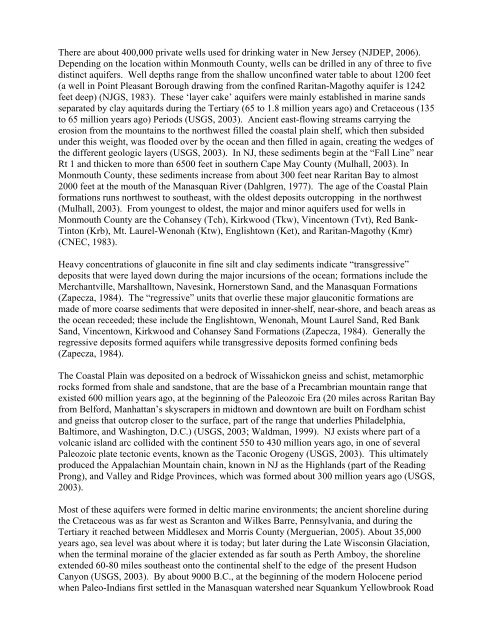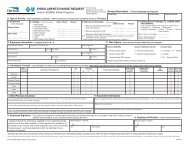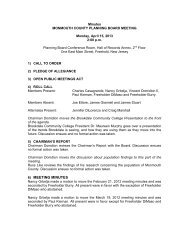NATURAL and CULTURAL FEATURES of MONMOUTH COUNTY
NATURAL and CULTURAL FEATURES of MONMOUTH COUNTY
NATURAL and CULTURAL FEATURES of MONMOUTH COUNTY
You also want an ePaper? Increase the reach of your titles
YUMPU automatically turns print PDFs into web optimized ePapers that Google loves.
There are about 400,000 private wells used for drinking water in New Jersey (NJDEP, 2006).<br />
Depending on the location within Monmouth County, wells can be drilled in any <strong>of</strong> three to five<br />
distinct aquifers. Well depths range from the shallow unconfined water table to about 1200 feet<br />
(a well in Point Pleasant Borough drawing from the confined Raritan-Magothy aquifer is 1242<br />
feet deep) (NJGS, 1983). These ‘layer cake’ aquifers were mainly established in marine s<strong>and</strong>s<br />
separated by clay aquitards during the Tertiary (65 to 1.8 million years ago) <strong>and</strong> Cretaceous (135<br />
to 65 million years ago) Periods (USGS, 2003). Ancient east-flowing streams carrying the<br />
erosion from the mountains to the northwest filled the coastal plain shelf, which then subsided<br />
under this weight, was flooded over by the ocean <strong>and</strong> then filled in again, creating the wedges <strong>of</strong><br />
the different geologic layers (USGS, 2003). In NJ, these sediments begin at the “Fall Line” near<br />
Rt 1 <strong>and</strong> thicken to more than 6500 feet in southern Cape May County (Mulhall, 2003). In<br />
Monmouth County, these sediments increase from about 300 feet near Raritan Bay to almost<br />
2000 feet at the mouth <strong>of</strong> the Manasquan River (Dahlgren, 1977). The age <strong>of</strong> the Coastal Plain<br />
formations runs northwest to southeast, with the oldest deposits outcropping in the northwest<br />
(Mulhall, 2003). From youngest to oldest, the major <strong>and</strong> minor aquifers used for wells in<br />
Monmouth County are the Cohansey (Tch), Kirkwood (Tkw), Vincentown (Tvt), Red Bank-<br />
Tinton (Krb), Mt. Laurel-Wenonah (Ktw), Englishtown (Ket), <strong>and</strong> Raritan-Magothy (Kmr)<br />
(CNEC, 1983).<br />
Heavy concentrations <strong>of</strong> glauconite in fine silt <strong>and</strong> clay sediments indicate “transgressive”<br />
deposits that were layed down during the major incursions <strong>of</strong> the ocean; formations include the<br />
Merchantville, Marshalltown, Navesink, Hornerstown S<strong>and</strong>, <strong>and</strong> the Manasquan Formations<br />
(Zapecza, 1984). The “regressive” units that overlie these major glauconitic formations are<br />
made <strong>of</strong> more coarse sediments that were deposited in inner-shelf, near-shore, <strong>and</strong> beach areas as<br />
the ocean receeded; these include the Englishtown, Wenonah, Mount Laurel S<strong>and</strong>, Red Bank<br />
S<strong>and</strong>, Vincentown, Kirkwood <strong>and</strong> Cohansey S<strong>and</strong> Formations (Zapecza, 1984). Generally the<br />
regressive deposits formed aquifers while transgressive deposits formed confining beds<br />
(Zapecza, 1984).<br />
The Coastal Plain was deposited on a bedrock <strong>of</strong> Wissahickon gneiss <strong>and</strong> schist, metamorphic<br />
rocks formed from shale <strong>and</strong> s<strong>and</strong>stone, that are the base <strong>of</strong> a Precambrian mountain range that<br />
existed 600 million years ago, at the beginning <strong>of</strong> the Paleozoic Era (20 miles across Raritan Bay<br />
from Belford, Manhattan’s skyscrapers in midtown <strong>and</strong> downtown are built on Fordham schist<br />
<strong>and</strong> gneiss that outcrop closer to the surface, part <strong>of</strong> the range that underlies Philadelphia,<br />
Baltimore, <strong>and</strong> Washington, D.C.) (USGS, 2003; Waldman, 1999). NJ exists where part <strong>of</strong> a<br />
volcanic isl<strong>and</strong> arc collided with the continent 550 to 430 million years ago, in one <strong>of</strong> several<br />
Paleozoic plate tectonic events, known as the Taconic Orogeny (USGS, 2003). This ultimately<br />
produced the Appalachian Mountain chain, known in NJ as the Highl<strong>and</strong>s (part <strong>of</strong> the Reading<br />
Prong), <strong>and</strong> Valley <strong>and</strong> Ridge Provinces, which was formed about 300 million years ago (USGS,<br />
2003).<br />
Most <strong>of</strong> these aquifers were formed in deltic marine environments; the ancient shoreline during<br />
the Cretaceous was as far west as Scranton <strong>and</strong> Wilkes Barre, Pennsylvania, <strong>and</strong> during the<br />
Tertiary it reached between Middlesex <strong>and</strong> Morris County (Merguerian, 2005). About 35,000<br />
years ago, sea level was about where it is today; but later during the Late Wisconsin Glaciation,<br />
when the terminal moraine <strong>of</strong> the glacier extended as far south as Perth Amboy, the shoreline<br />
extended 60-80 miles southeast onto the continental shelf to the edge <strong>of</strong> the present Hudson<br />
Canyon (USGS, 2003). By about 9000 B.C., at the beginning <strong>of</strong> the modern Holocene period<br />
when Paleo-Indians first settled in the Manasquan watershed near Squankum Yellowbrook Road

















